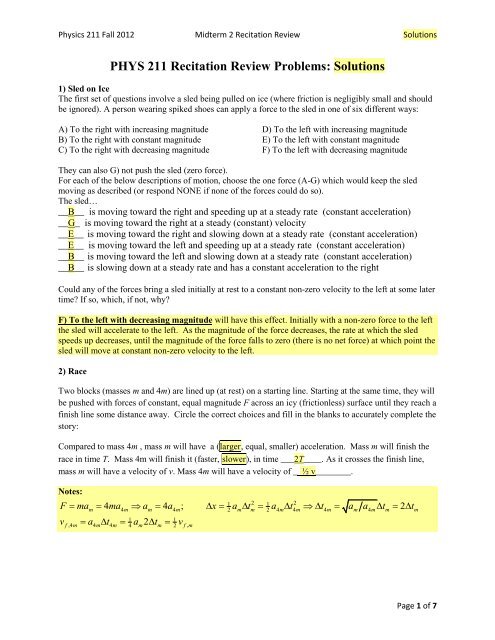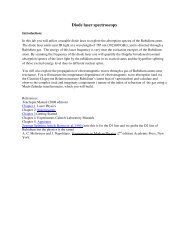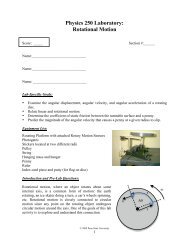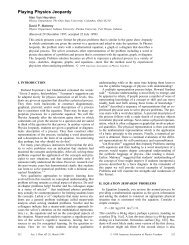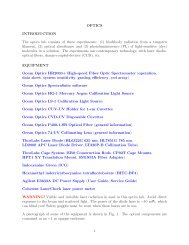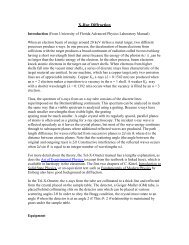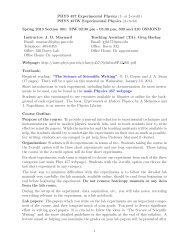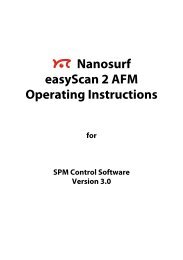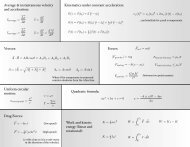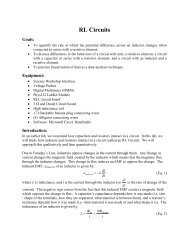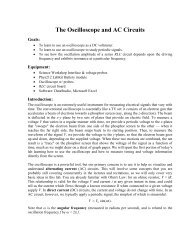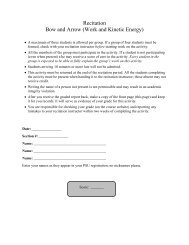PHYS 211 Recitation Review Problems: Solutions
PHYS 211 Recitation Review Problems: Solutions
PHYS 211 Recitation Review Problems: Solutions
Create successful ePaper yourself
Turn your PDF publications into a flip-book with our unique Google optimized e-Paper software.
Physics <strong>211</strong> Fall 2012 Midterm 2 <strong>Recitation</strong> <strong>Review</strong> <strong>Solutions</strong><br />
<strong>PHYS</strong> <strong>211</strong> <strong>Recitation</strong> <strong>Review</strong> <strong>Problems</strong>: <strong>Solutions</strong><br />
1) Sled on Ice<br />
The first set of questions involve a sled being pulled on ice (where friction is negligibly small and should<br />
be ignored). A person wearing spiked shoes can apply a force to the sled in one of six different ways:<br />
A) To the right with increasing magnitude D) To the left with increasing magnitude<br />
B) To the right with constant magnitude E) To the left with constant magnitude<br />
C) To the right with decreasing magnitude F) To the left with decreasing magnitude<br />
They can also G) not push the sled (zero force).<br />
For each of the below descriptions of motion, choose the one force (A-G) which would keep the sled<br />
moving as described (or respond NONE if none of the forces could do so).<br />
The sled…<br />
__B__ is moving toward the right and speeding up at a steady rate (constant acceleration)<br />
__G_ is moving toward the right at a steady (constant) velocity<br />
__E__ is moving toward the right and slowing down at a steady rate (constant acceleration)<br />
__E__ is moving toward the left and speeding up at a steady rate (constant acceleration)<br />
__B__ is moving toward the left and slowing down at a steady rate (constant acceleration)<br />
__B__ is slowing down at a steady rate and has a constant acceleration to the right<br />
Could any of the forces bring a sled initially at rest to a constant non-zero velocity to the left at some later<br />
time? If so, which, if not, why?<br />
F) To the left with decreasing magnitude will have this effect. Initially with a non-zero force to the left<br />
the sled will accelerate to the left. As the magnitude of the force decreases, the rate at which the sled<br />
speeds up decreases, until the magnitude of the force falls to zero (there is no net force) at which point the<br />
sled will move at constant non-zero velocity to the left.<br />
2) Race<br />
Two blocks (masses m and 4m) are lined up (at rest) on a starting line. Starting at the same time, they will<br />
be pushed with forces of constant, equal magnitude F across an icy (frictionless) surface until they reach a<br />
finish line some distance away. Circle the correct choices and fill in the blanks to accurately complete the<br />
story:<br />
Compared to mass 4m , mass m will have a (larger, equal, smaller) acceleration. Mass m will finish the<br />
race in time T. Mass 4m will finish it (faster, slower), in time ___2T____. As it crosses the finish line,<br />
mass m will have a velocity of v. Mass 4m will have a velocity of _ ½ v________.<br />
Notes:<br />
F ma 4ma a 4 a ; x a t a t t a a t 2t<br />
1 2 1 2<br />
m 4m m 4m 2 m m 2 4m 4m 4m m 4m m m<br />
v a t a 2t v<br />
1 1<br />
f ,4m 4m 4 m 4 m m 2 f , m<br />
Page 1 of 7
Physics <strong>211</strong> Fall 2012 Midterm 2 <strong>Recitation</strong> <strong>Review</strong> <strong>Solutions</strong><br />
3) Cart<br />
For a lecture demo in front of class, a little cart (mass 0.5 kg) travels<br />
on a long, straight, level air track. Shown at right is a graph of<br />
velocity vs. time of the cart. Let's define "right" to be the positive<br />
direction.<br />
1. What is the net force (with correct sign) on the cart at t=3 s?<br />
A) 0 N<br />
m<br />
B) +3 N<br />
v<br />
6<br />
a s<br />
4<br />
m<br />
2<br />
C) -3 N<br />
s<br />
t<br />
1.5 s<br />
D) +2 N<br />
m<br />
F ma 0.5kg 4 2 2 N<br />
s<br />
E) -2 N<br />
+4 m/s<br />
+2 m/s<br />
-2 m/s<br />
+velocity<br />
time (s)<br />
1 2 3 4 5<br />
2. At t=2.5 seconds, how would you describe what the car is doing?<br />
A) It is moving to the right with steady speed.<br />
B) It is moving to the right with decreasing speed<br />
C) It is moving to the left with steady speed<br />
D) It is moving to the left with decreasing speed<br />
E) None of the above/not enough information<br />
3. At t=5 seconds, the air for the air track is suddenly turned off, so kinetic friction (alone) causes<br />
the cart to grind to a halt in another 0.5 sec. During that half-second when the cart is stopping,<br />
call the force of friction on the cart by the track f CT .<br />
What can you conclude about the frictional force f' TC on the track by the cart during this time?<br />
(assume the mass of the track itself is 5.0 kg, i.e. ten times the mass of the little cart)<br />
A) f' TC = -10 f CT<br />
B) f' TC = +10 f CT<br />
C) f' TC = -f CT /10<br />
D) f' TC = -f CT<br />
E) f' TC = +f CT<br />
Newton’s 3 rd Law: Action-reaction pairs are equal and opposite<br />
4. In the previous question, (during the half-second when the car stops due to friction) what is the<br />
coefficient of kinetic friction between the cart and the track?<br />
A) 0.8<br />
m<br />
B) 0.5<br />
v<br />
2<br />
a s<br />
4 m<br />
2<br />
C) 0.4<br />
s<br />
t<br />
0.5 s<br />
D) 0.2<br />
m<br />
4 2<br />
a s<br />
E) 0.1<br />
F ma mg<br />
m 0.4<br />
g 10<br />
2<br />
s<br />
Page 2 of 7
Physics <strong>211</strong> Fall 2012 Midterm 2 <strong>Recitation</strong> <strong>Review</strong> <strong>Solutions</strong><br />
4) Rocket<br />
The questions on this page all refer to this (highly simplified) scenario.<br />
A rocket is launched and travels straight up (defined to be positive here).<br />
The net force on the rocket as a function of time is shown in this graph.<br />
1. Between t=1 hr and 3 hrs, what happens to the speed of the rocket?<br />
A) The rocket is speeding up the whole time<br />
B) The rocket is slowing down the whole time.<br />
C) The rocket is moving with a constant speed the whole time.<br />
D) The rocket is speeding up for a while, and then it slows down.<br />
E) There is not enough information given to decide.<br />
+4<br />
+2<br />
Net Force (MegaNewtons)<br />
1<br />
2 3 4 5<br />
time (hrs)<br />
Force is always positive,<br />
in direction of motion<br />
Inside the rocket, there is some payload, as shown. On the left is<br />
Rover I (RI). On the right is Rover II (RII), which is identical to RI.<br />
Sitting on top of RII is a sensor package (S) which weighs much less<br />
than the Rovers do.<br />
Rover I (RI)<br />
up<br />
Sensor (S)<br />
Rover II (RII)<br />
2. At t=1 hr, how does the acceleration of sensor (S) compare to the<br />
Floor<br />
acceleration of Rover II?<br />
A) a(S) = a(RII) B) a(S) < a(RII) C) a(S) > a(RII)<br />
D) Without knowing more numbers, we can’t tell how the accelerations of S and RII compare.<br />
They are attached same acceleration<br />
3. At t=1 hr, how does the normal force of the ground on Rover I (RI) compare to that of the<br />
ground on Rover II?<br />
A) N(RI) = N(RII) B) N(RI) < N(RII) C) N(RI) > N(RII)<br />
D) Without knowing more numbers, we can’t tell how the normal forces on RI and RII compare.<br />
RII is effectively “heavier” because of the sensor package sitting on top of it.<br />
4. A student is asked to sketch a force diagram for Rover II only, as viewed from the ground just<br />
after launch ("N" represents "normal", W represents "Weight") Note that none of the diagrams<br />
are complete, because the student has not properly labeled forces "ON object BY object", but<br />
which is best?<br />
m a<br />
N<br />
N<br />
N'<br />
N<br />
N'<br />
W W W W<br />
A)<br />
B) C) D) E)<br />
The normal force from the ground is up, from the sensor package is down<br />
Page 3 of 7
Physics <strong>211</strong> Fall 2012 Midterm 2 <strong>Recitation</strong> <strong>Review</strong> <strong>Solutions</strong><br />
5. In class we watched a video of a hammer and feather dropped on the moon. Both stared from<br />
the same height and landed on the lunar surface. Assume that the mass of the hammer is 100<br />
times greater than the mass of the feather.<br />
During the time that they fall freely, consider the following two statements:<br />
i) The net force on the hammer is equal to the net force on the feather.<br />
ii) The net acceleration of the hammer is equal to the net acceleration on the feather.<br />
A) Without knowing more numbers, we cannot decide<br />
B) Both statements are true<br />
C) i is true, but ii is false.<br />
D) i is false, but ii is true<br />
E) Both statements are false.<br />
The forces (mg) are DIFFERENT because of the different masses. However the acceleration of<br />
both is the same, namely g moon .<br />
6. A rover is moving about on a flat Martian surface. Its position as a function of time is given<br />
m 2<br />
m<br />
x t 3 t , y t 5 t, z t 0<br />
extremely precisely by 2 <br />
s<br />
(You should assume there is rolling friction for the rover on Mars!)<br />
What can you conclude about the net force on the rover?<br />
s<br />
A) There is not enough information given to conclude anything precise about the net force.<br />
B) The magnitude of the net force is a constant in time, and always points in the + ˆ i direction.<br />
C) The magnitude of the net force is not constant in time, but always points in the + ˆ i direction.<br />
D) The magnitude of the net force is a constant in time, but the direction changes with time.<br />
E) The magnitude of the net force is not constant in time, and the direction also changes with<br />
time.<br />
Find the acceleration by taking 2 time derivatives. Only a<br />
<br />
x (t) = 6 m/s 2 is non-zero. Because the<br />
acceleration is constant in the +i direction, so is the net force.<br />
7. A penny sits on an old fashioned (flat, horizontal) circular record turntable,<br />
rotating at a constant speed as illustrated in the "top-down" diagram at the right.<br />
1¢<br />
Which of the following sets of vectors best describes the directions of the velocity,<br />
acceleration, and net force acting on the penny at the point indicated in the<br />
diagram? (Note: this is not a force diagram, I'm just asking for the direction of<br />
these three different vectors)<br />
F<br />
v<br />
a<br />
F<br />
a=0<br />
v<br />
F<br />
a=0<br />
v<br />
F<br />
a<br />
v<br />
F<br />
a<br />
v<br />
A)<br />
B) C)<br />
D) E)<br />
Page 4 of 7
Physics <strong>211</strong> Fall 2012 Midterm 2 <strong>Recitation</strong> <strong>Review</strong> <strong>Solutions</strong><br />
8) Car<br />
A car (mass M) is going around a banked curve of radius R<br />
and bank angle at constant speed v. Sitting on its very well<br />
polished (frictionless) hood is a car top carrier (mass m)<br />
which the occupants forgot to secure. Assume that the curve<br />
is very icy (frictionless between road and car) but that the<br />
car is traveling at the correct velocity to make it through the<br />
turn.<br />
A) Draw FBDs for both the car and the carrier.<br />
Car<br />
Carrier<br />
a<br />
B) Given that the car makes it around the frictionless bank, does the carrier? HINT: After you write<br />
your two equations (two force components) divide them – this will get rid of things in which you<br />
are uninterested.<br />
It will. The equations are quite similar. The vertical component of the normal/interaction forces must<br />
cancel gravity. The horizontal component must provide centripetal acceleration:<br />
<br />
<br />
<br />
<br />
<br />
<br />
<br />
<br />
<br />
<br />
<br />
2<br />
2<br />
F x,car N FCarrier,Car sin<br />
Ma v<br />
cent.<br />
M <br />
R v<br />
tan<br />
<br />
<br />
Fy,car : N FCarrier,Car cos<br />
F Rg<br />
G,Car<br />
Mg <br />
2<br />
2<br />
F x,car FCarrier,Car sin<br />
ma v<br />
cent.<br />
m <br />
R v<br />
tan<br />
<br />
Fy,car : FCarrier,Car cos<br />
F Rg<br />
G,Carrier<br />
mg<br />
<br />
C) How does the mass of the car top carrier affect the velocity at which the car must travel to make it<br />
around the frictionless banked curve?<br />
It doesn’t – note that the interaction force divides out along with the normal force from the curve<br />
Page 5 of 7
Physics <strong>211</strong> Fall 2012 Midterm 2 <strong>Recitation</strong> <strong>Review</strong> <strong>Solutions</strong><br />
9) Towing a Sled<br />
A mother tows her daughter on a sled on level ice. The<br />
friction between the sled and the ice is negligible, and<br />
the tow rope makes an angle of to the horizontal. The<br />
combined mass of the sled and the child is M . The sled<br />
has an acceleration in the horizontal direction of<br />
magnitude a.<br />
A) What is the tension T in the rope?<br />
We draw the free body diagram and acceleration diagram from the sled and note that<br />
only the horizontal component of the tension is responsible for the acceleration,<br />
allowing us to solve for the acceleration:<br />
a<br />
T cos<br />
Ma T <br />
Ma<br />
cos<br />
B) What is the magnitude of the normal force N exerted by the ice on the sled?<br />
The normal force we get from the vertical component:<br />
N T sin Mg N Mg T sin Mg Ma tan<br />
N<br />
Now the mother starts up an incline (angle ).<br />
She continues to pull at the same relative angle<br />
and at the same acceleration a. What new<br />
tension and normal force must exist?<br />
Work in a tilted coordinate<br />
system where the acceleration<br />
vector is along the “x-axis”<br />
and the normal to the plane it<br />
the “y-axis.” Then we find:<br />
a<br />
Ma Mg sin <br />
T cos<br />
Mg sin Ma T <br />
cos<br />
N T sin Mg cos N Mg cos T sin Mg cos Ma Mg sin tan<br />
N<br />
Check: These reduce to our previous expressions in the limit that goes to zero.<br />
<br />
<br />
Page 6 of 7
Physics <strong>211</strong> Fall 2012 Midterm 2 <strong>Recitation</strong> <strong>Review</strong> <strong>Solutions</strong><br />
10) Blocks<br />
A block of mass m 1 is sitting on top of a more massive<br />
block of mass m 2 that rests on a horizontal table.<br />
There is a horizontal force of magnitude F pulling the<br />
top block to the right. There is friction between the<br />
two blocks and between the bottom block and the<br />
table, both with kinetic coefficient of friction μ . The<br />
blocks are connected by a massless, ideal rope that<br />
goes around a fixed massless and frictionless pulley.<br />
A) Draw FBDs and acceleration diagrams for both blocks 1 & 2<br />
1 2<br />
There are two action-reaction pairs – the friction and normal forces<br />
between the blocks F f .<br />
12<br />
and<br />
12<br />
B) What constraint relationship is there between the<br />
acceleration of block 1 and block 2 given the coordinate<br />
system(s) that you defined in your acceleration diagrams?<br />
a<br />
a<br />
We define the coordinate systems of the two blocks backward from each other so that a 1 = a 2 = a. If we<br />
chose to make “to the right” positive then the accelerations would have opposite signs.<br />
<br />
<br />
C) From your FBDs & acceleration diagrams write four equations of motion using Newton’s 2 nd law<br />
<br />
<br />
F F T f m a F : F F m g<br />
x,1 12 1 y,1 12 G,1 1<br />
F T f f m a F : N F F m m g<br />
x,2 2G 12 2 y,2 12 G2 1 2<br />
D) How many unknowns appear in your equations? Are any of your equations irrelevant, i.e. contain<br />
unknown(s) that appear nowhere else and whose value(s) you don’t care about? If this number is<br />
bigger than 4, do you have any other equations relating these unknowns?<br />
We have six unknowns: T, f12, f2G, F12<br />
, N,<br />
a<br />
None of the equations are irrelevant since we need the normal forces to think about friction.<br />
We have two other equations relating friction and normal forces<br />
E) What are the frictional forces on the blocks (in terms of known quantities)?<br />
; <br />
f F m g<br />
12 12 1<br />
f N m m g<br />
2G<br />
1 2<br />
F) Solve for the acceleration a of the system. Note that to eliminate the tension T you might just add<br />
(or subtract) two of your equations from part C.<br />
We can add the two horizontal equations to cancel the tension:<br />
F T f T f f m a m a m m a<br />
12 2G<br />
12 1 2 1 2<br />
1 1<br />
<br />
<br />
1 2<br />
a F 2f12 f2G<br />
F 2m1g m1 m2<br />
g a<br />
m1 m2 m1 m2 <br />
m1 m2<br />
<br />
<br />
<br />
<br />
<br />
<br />
<br />
<br />
F g 3m m<br />
<br />
Page 7 of 7


